- Details
- Hits: 1360
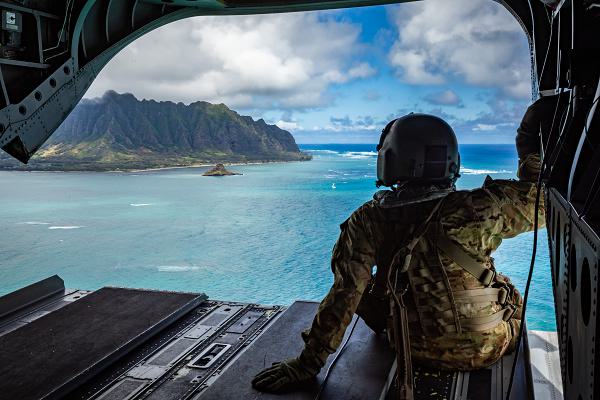
Everyone who has ever served in the armed forces remembers the shock, both physically and psychologically, experienced in the first days of Basic Training. In this photo by Sergeant Lianne Hirano, Sergeant Shelby Lewis, a flight engineer assigned to Company B, 2nd Battalion, 211th Aviation Regiment, 103rd Troop Command, Hawaii Army National Guard, conducts flight operations as part of the Recruit Sustainment Program. In an effort to lessen the “shock & awe” of Basic for new recruits, this multi-phase program gives new recruits vital information and physical training to prepare them for Basic Training.
The Hawaii National Guard operates a Regional Training Institute at Waimanalo, Hawaii, that primarily focuses on ensuring these new recruits are “mentally prepared, administratively correct, and physically ready” to successfully complete basic training. The training begins with issuance of the Army’s “Blue Book” ; a comprehensive guide to help get recruits comfortable with the military terminology and the protocols expected of them. The book also includes information on the Army’s core values, rank structure, courtesies, and customs. Recruits are taught military time, the phonetic alphabet, and the “Soldiers Creed”. The goal is to acquaint recruits with the knowledge they will need to navigate life in the military before they ship off to basic training.
- Details
- Hits: 1194
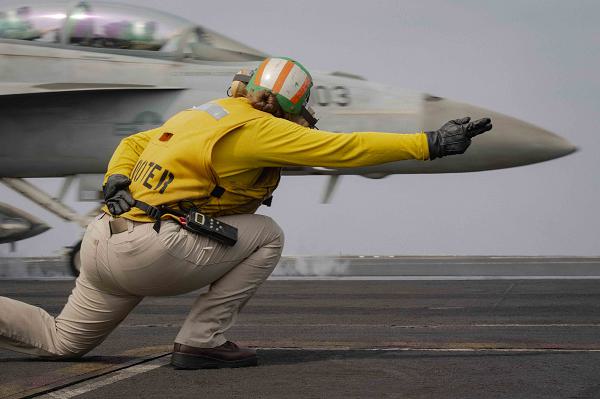
Red Sea. (March 5, 2024): For the Sailors and Marines of the Eisenhour Aircraft Carrier Strike Group, the past four months have been spent at sea defending against ballistic missiles and flying attack drones fired by Iranian-backed Houthis from Yemen. In this photo by AE3 Lauren Duval, a “shooter” signals the launch of an F/A-18 Super Hornet from the famous “Fighting Swordsmen” of Strike Fighter Squadron 32 from the flight deck. The Strike Group has been on patrol in the Middle East since November with some of its ships having been on location since October.
As of Wednesday, the strike group — which includes the cruiser USS Philippine Sea, the destroyers USS Mason, Gravely, and Laboon conducted more than 95 intercepts of drones, anti-ship ballistic missiles, cruise missiles, and made more than 240 self-defense strikes on more than 50 Houthi targets in Yemen.
The latest threat is fast unmanned vessels that are fired through the water and are remote controlled by the enemy. These unmanned bombs are difficult to detect and defeat, especially at night.
- Details
- Hits: 1299
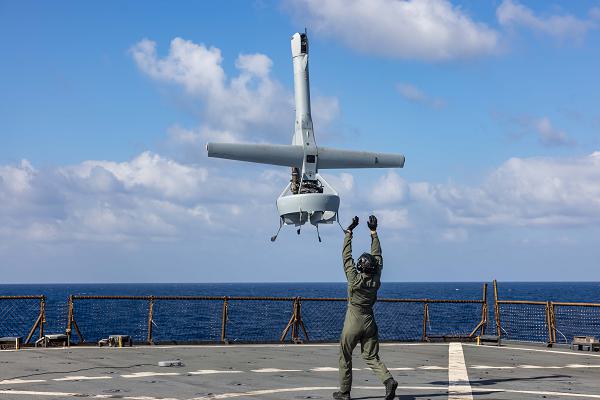
Mediterranean Sea. (March 15, 2024): When the Navy wants to look over the horizon, it sends out the V-BAT. In this photo by Marine Corporal Rafael Brambila-Pelayo, a V-BAT uncrewed aerial system launches from the dock landing ship USS Carter Hall to become the ship’s “eye in the sky”.
This unique drone gives situational awareness to commanders who use it for surveillance and intelligence gathering. It’s light weight (125 lbs.) which allows the system to be deployed by a 2-person team and packs up to fit in the back of a pickup truck. The system deploys quickly, going from package to flight in under twenty minutes.
Nine feet long with a ten-foot wingspan, the V-Bat can travel up to 56 mph for up to ten hours with a ceiling of 20,000 feet. What makes the unit remarkable are its electro-optical (EO)/mid-wave infrared (MWIR) cameras that provide long-range imaging abilities, image stabilization, and high-speed thermal imaging. The V-BAT can also transmit real-time video and imagery to its control station via a data link.
- Details
- Hits: 1324
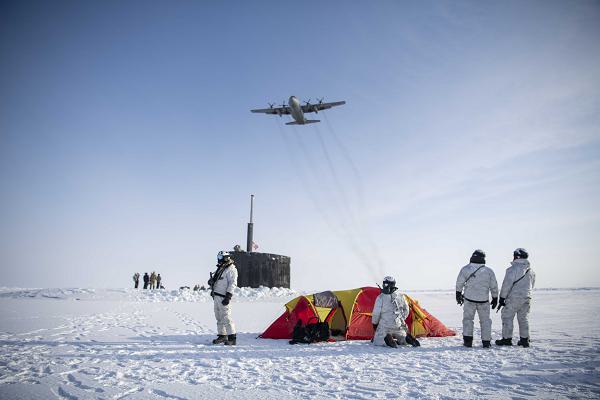
Undisclosed Location. Alaska. (March 9, 2024): Crashing a billion-dollar submarine through solid ice to the surface is no easy task. In this photo by MC1 Jeff Atherton, an Air Force C-130 Hercules flies over a group of Navy SEALs, Norwegian naval special operations commandos, and the attack submarine USS Hampton. The U.S. and Norwegian forces are participating in Arctic Edge, an annual exercise to test submarine capabilities in an Arctic environment.
For years, America’s Navy has used submarines to patrol the arctic seas beneath the ice at the top of the world. While the sea ice gives concealment from observation from above, it is necessary for submarines to punch through that ice to communicate, launch missiles, or support surface activity.
But how does a sub captain know where it is safe to surface?
- Details
- Hits: 1260

Al Udeid Air Base, Qatar. (March 9, 2024): As early as the first World War, American servicemembers have laced up their gloves and gone a few rounds to demonstrate their warrior spirit. In this photo by Technical Sergeant Alexander Cook, Air Force Senior Airman Lian Espinoza, assigned to the 379th Expeditionary Force Support Squadron, delivers a blow to her opponent during the Rumble in the Deid II boxing event. Espinoza belongs to a boxing fraternity who have served our nation including some of the sport’s brightest stars.
The military has long encouraged boxing as a form of self-defense training and as a means to build discipline or relieve tension among the troops. Its roots can be traced to President Theodore Roosevelt, an avid boxing enthusiast, who petitioned the senior military to hold boxing matches among the troops. During the World Wars, bouts were organized primarily among Sailors as a form of recreation and to boost morale.
Today, military boxers participate in base-wide, inter-service, and USA Boxing sanctioned amateur tournaments throughout the year and each service fields its own team.
Army Cadets at the U.S. Military Academy are required to take a boxing class as freshman and the West Point Boxing Team has produced a number of All-Army boxers. The Marines produced the first active-duty member to qualify for the Olympics in 1992 and the Air Force Falcons team has won an astounding 18 national championships.
Boxing will continue to be a vital tool to boost morale and fuel the warrior spirit in today’s military.
- Details
- Hits: 1310
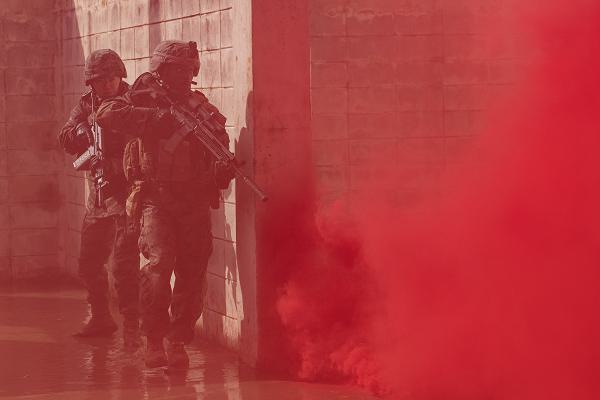
Camp Mujuk, Republic of Korea. (March 14, 2024): There is one environment where America’s mighty warplanes, powerful tanks, and high-tech weapons are virtually useless. In this photo by Lance Corporal Evelyn Doherty, Marine Corps Lance Corporal Ahmier Fillmore and a fellow Republic of Korea Marine navigate in close quarters combat during urban warfare training. It is combat in the cities that negates many of the advantages of modern militaries while offering significant advantages to the defenders.
Considered to be the most difficult form of warfare, fighting in urban areas is complicated by the presence of civilians, unfamiliar terrain, and the three-dimensional nature of the battlefield. Fighting in urban areas also negates the advantages that one side may have in armor, heavy artillery, or air support.
The U.S. Military is bound by the Geneva Conventions, the laws of war governing the amount of force which can be used in an area where there are known to be civilians. This necessitates severely limiting artillery and air support to limit civilian casualties. Worse for the attacking force, it is often difficult to distinguish civilians from other armed combatants such as militia groups and gangs. In fact, many times an enemy will deliberately blend with civilians to create a human shield for their forces.


